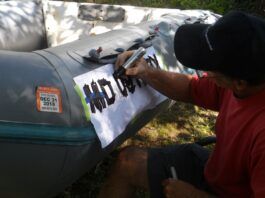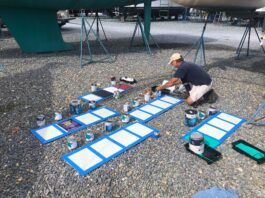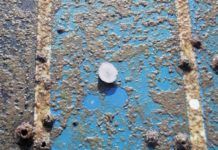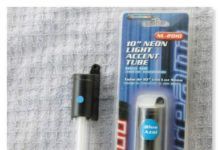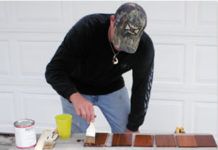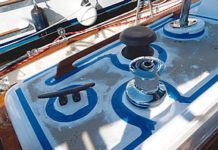Respect for the Mighty Barnacle
While gathering data for this months bottom paint report I took comfort in the notion that Im not the first to have barnacles on the brain. For seven years, Charles Darwin immersed himself in the study of barnacles, and with each passing year, he seemed to become more and more confounded. Darwins consternation-and later, an almost maniacal obsession with the barnacle-is well documented in Rebecca Stotts compelling book Darwin and the Barnacle.
Do-It-Yourself: Seeing Neon Blue
There are simply too many white lights in and around a municipal anchorage. A required white anchor light must have 360-degree visibility. But a white light at the tip of a mast can get lost in the stars or a background of city lights, making it a poor marker for a sailboat 60 feet below. Also, a light in the sky is not in the normal plane of view of other small vessels maneuvering in an anchorage. An additional white light on a stern arch is a better marker, but it also can become camouflaged by city lights onshore and will be obscured, by a small degree, by the mast. But Inland and International Rules state in part no other lights shall be exhibited, except such lights as cannot be mistaken for the lights specified in the Rules, which makes the growing use of LED flashing blue or white lights and non-flashing red, green, and pink lights illegal to use as anchor or on-deck lights. Such lights are easily confused for lighted buoys, channel markers, lighthouses, or police boats.
Do-It-Yourself: Salted Surfaces
While new finishes-paint, epoxy, or varnish-may be beautiful to look at, they are also as slick as can be when a little seawater hits the surface. You can cover your handiwork with nonskid tape; slather on a coat of bland nonskid paint; try one of the nonskid paint additives like crushed walnut shells (favored by PS Technical Editor Ralph Naranjo); or you can try an easy, age-old method that PS tester Drew Frye favors: salted varnish (or paint).
Bottom Paint Makeover
Practical Sailor has made its mark by diving deep into the boat owners rite of bottom painting. Over the years, we have slaved away, painting fiberglass samples with a multitude of formulations and placing them in harms way in various locations to gauge their performance. Weve come away with some strong ideas about what works and what doesn't for the do-it-yourselfer-and that includes the myriad ways boat owners can remove layers of bottom paint so they can start afresh.
Antifouling Paints Abroad
Practical Sailor has been conducting antifouling paint trials for years, but our focus almost exclusively has been on those paints that can be bought off-the-shelf at U.S retailers or are widely available in U.S. boatyards. Nevertheless, we often receive email questions from sailors abroad regarding antifouling paints sold in other countries. A number of readers have also have asked us about certain paints that are generally used only on commercial ships. These commercial paints can sometimes be procured at shipyards in major ports both in the U.S. and abroad.
Exterior Wood Finishes
After a brief-and for testers, much needed-hiatus from testing wood finishes, we recently launched a new long-term evaluation of exterior wood coatings. Our last round of tests, a two-year death match, wrapped up in 2011. Although the test field this go-around is smaller than the previous tests lineup, it includes some new products and some that have been reformulated since the last long-term test began in 2007.
Bottom Paint Checkup 2015
You know that youve been testing bottom paint too long when you start rooting for the slime and barnacles . . . or tunicates and seaweed, or sponges, or algae, or oysters . . . the whole lot of em. Go sea critters, go! If you ever felt an ounce of sympathy for the invertebrates that sailors spend so much money trying to defeat, then here is some news that will warm your barnacle-hugging heart. We just returned from pulling our 18-month antifouling-paint test panels, and the past year and a half has been very good to barnacles.
Sea Hawk Faces Stricter Scrutiny from EPA
Family-owned and -operated New Nautical Paints, the makers of Sea Hawk marine paints, is operating under an environmental compliance program that requires strict monitoring and reporting requirements for the next three years. The program is one of several punishments that a U.S. District Court judge in Miami handed down in December after New Nautical Coatings, its owners, and two employees pleaded guilty to violating U.S. laws regulating the manufacturing and distribution of pesticides.
Check that Antifouling Label
Shortly before this issue went to print, Practical Sailor learned that Irgarol, a pesticide commonly used as a boosting agent in antifouling paints, is in short supply in the United States. Although we have not fully investigated the ramifications of this news for boat owners, it seems likely that the supply of paints containing this pesticide will be exhausted sometime this year.
Repairing Worn Gelcoat
Regarding your blog post on restoring gelcoat (posted online March 18, 2014): Ive seen many similar articles over the years directed toward refinishing topsides. However, Ive seen no discussion about restoring decks. I have an 18-year-old boat, and Im beginning to see pinholes in the deck gelcoat, particularly on edges and curves where I suspect the gelcoat is thinner. Im curious what the experts would recommend.


































